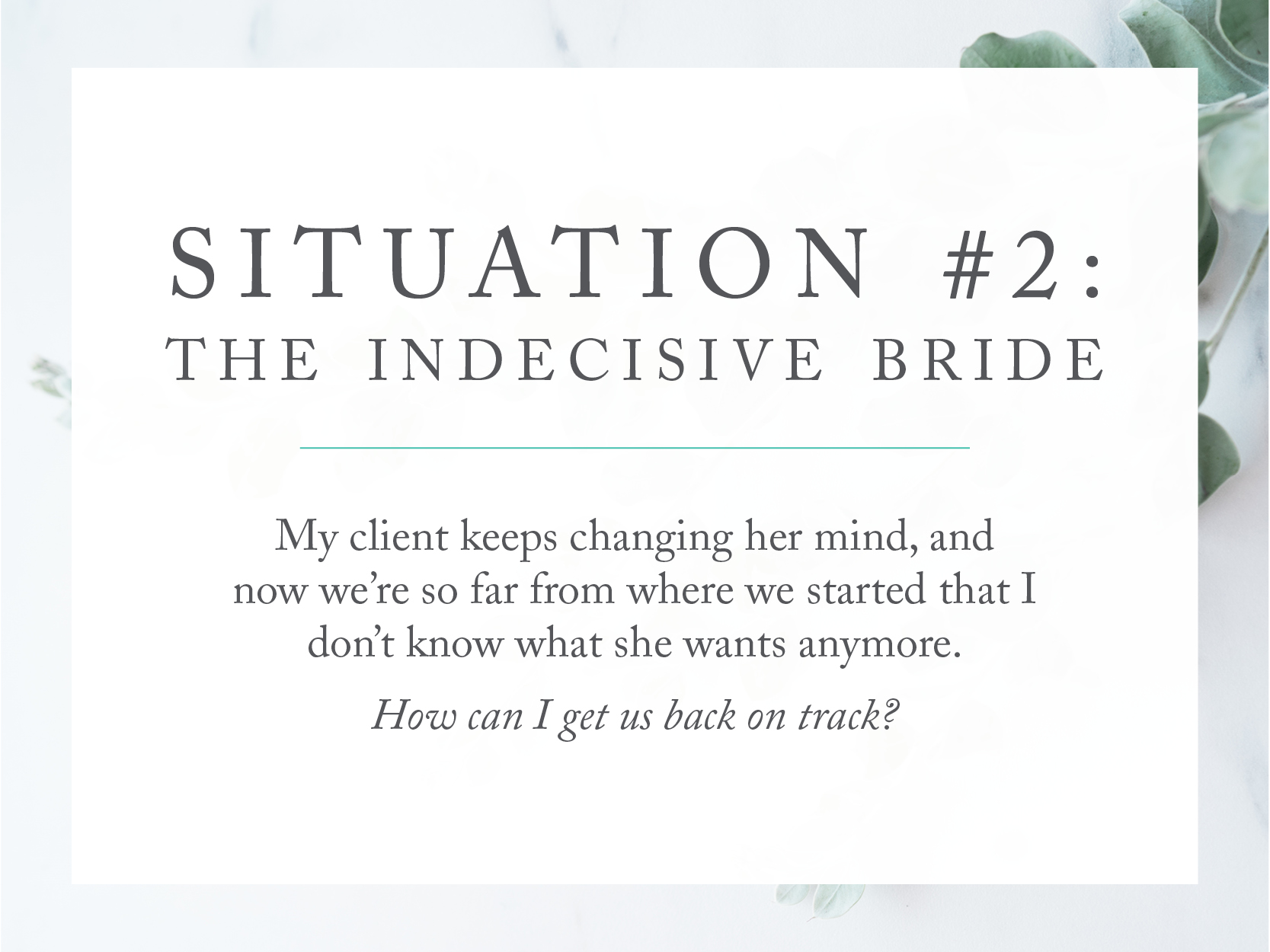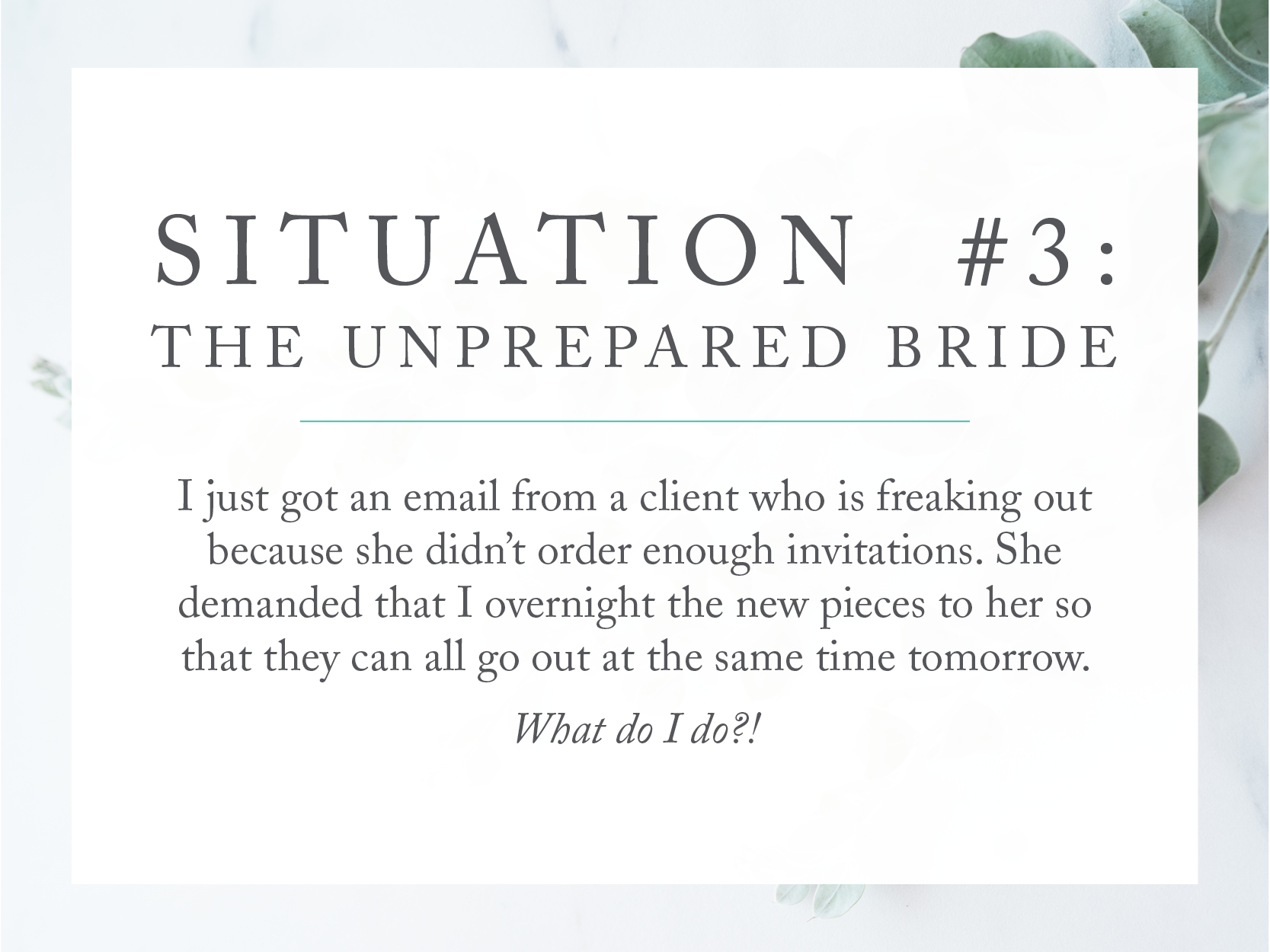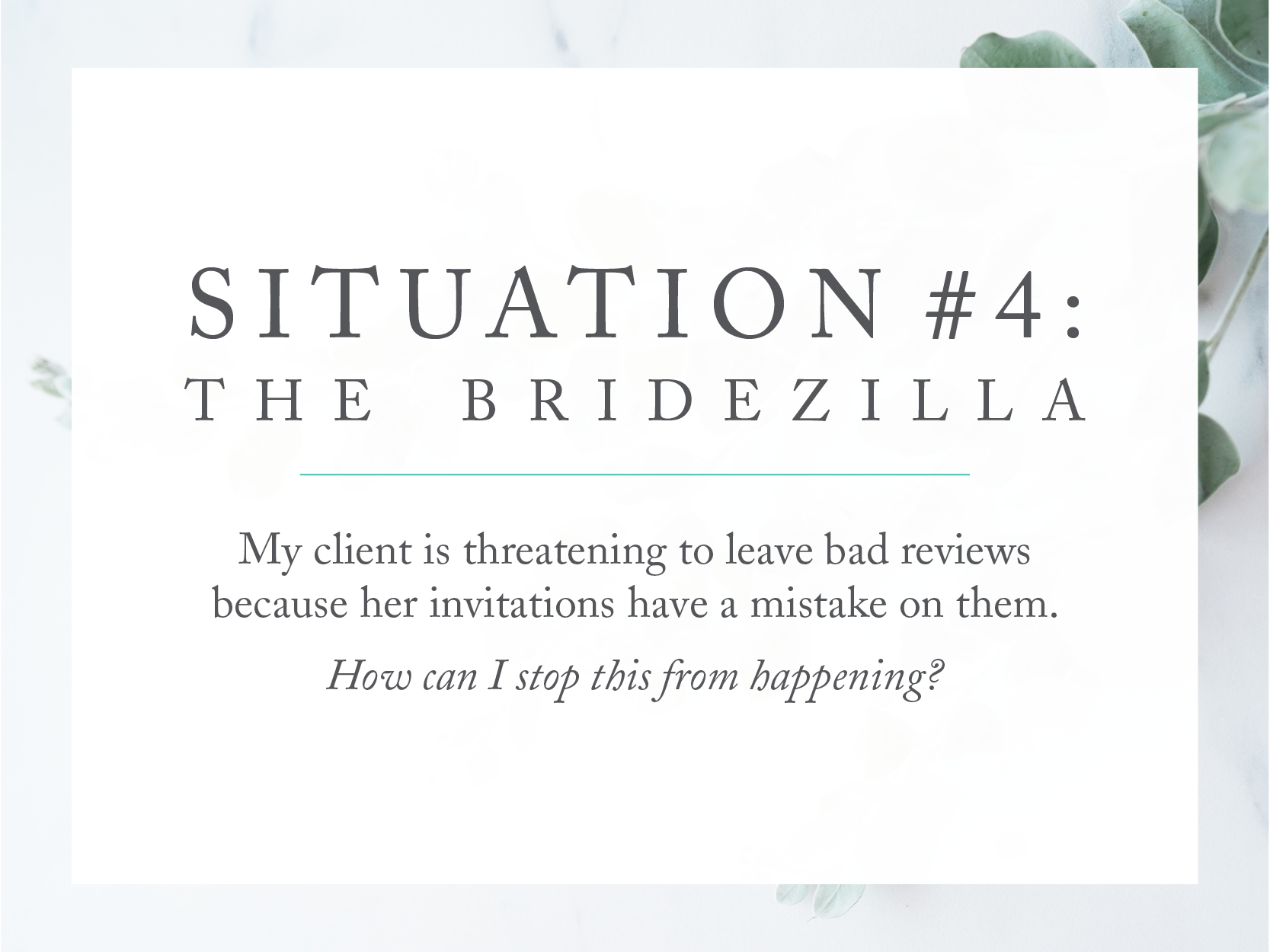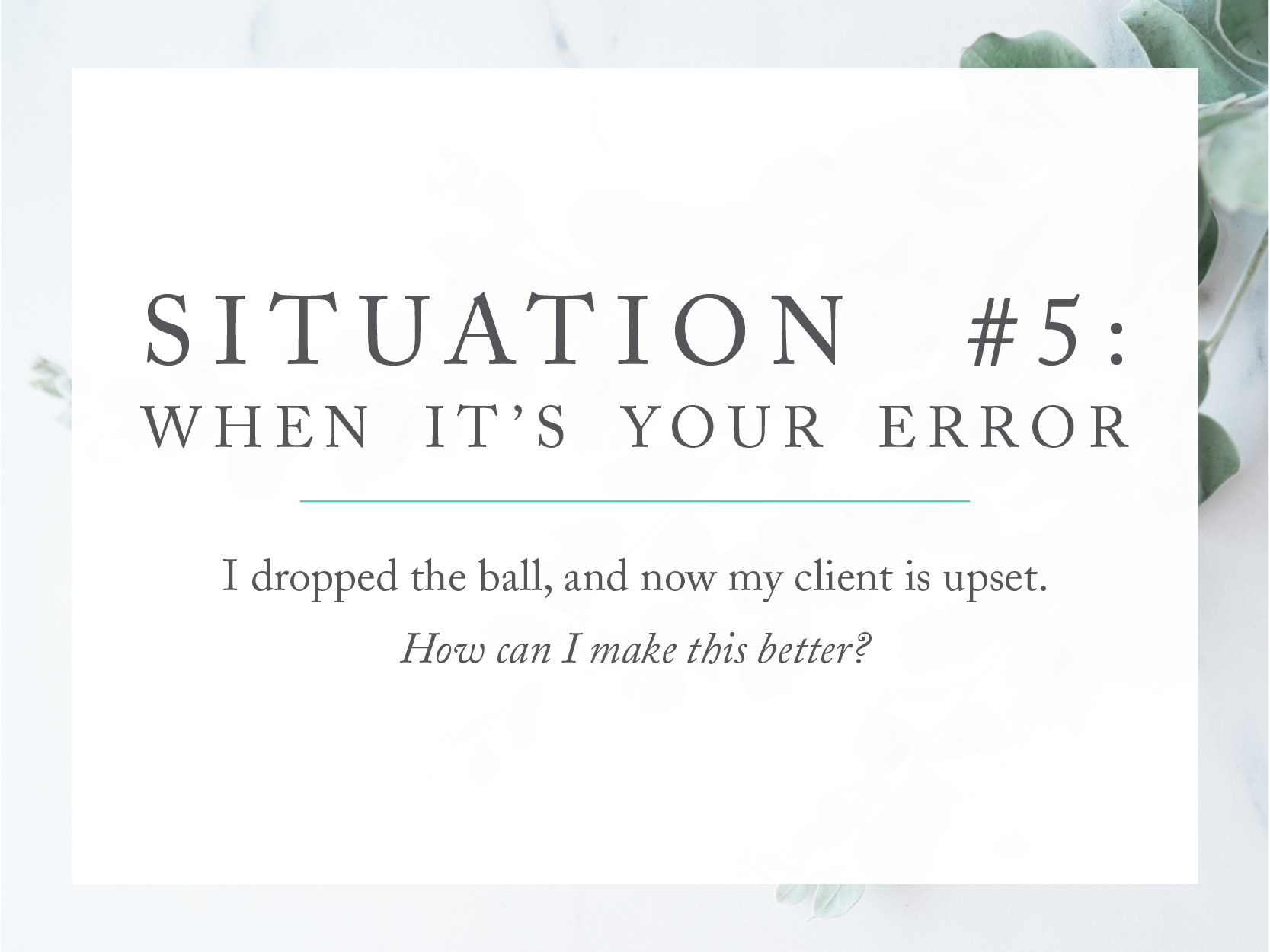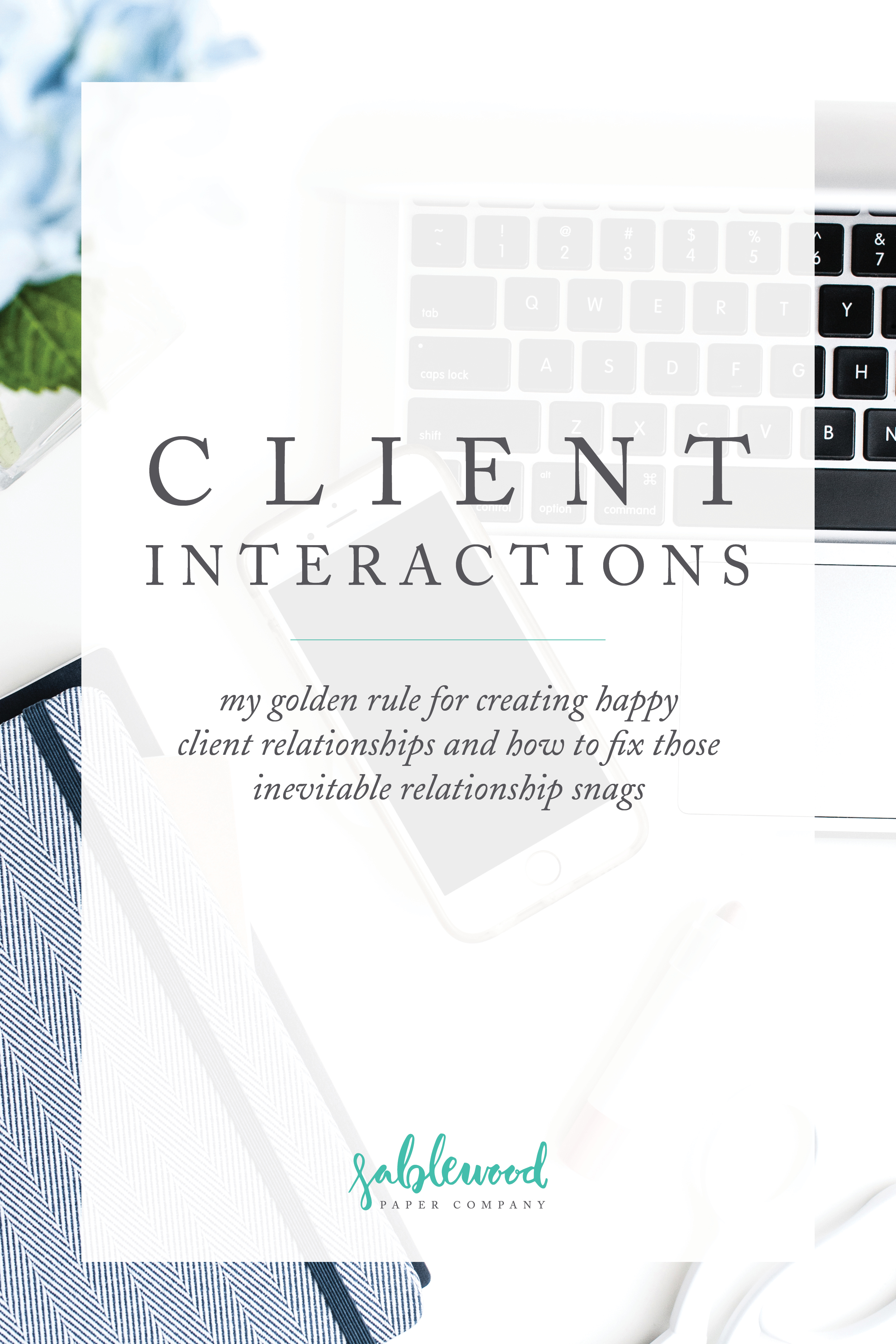
How can you start having better relationships with clients?
Let’s start off this week by getting a show of hands: how many of you have run into a problem of some kind with a client in the past? How many of you have dealt with a demanding client? How many of you have had to reign a client in?
Brides are a little bit like teenagers (and I really hope none of the brides-to-be out there take offense to this, ha!):
- If they sense you don’t know what you’re talking about, they instantly become experts on the topic and tell you what’s what.
- If you don’t tell them the ground rules right out of the gate, they will walk. all. over. you.
- Give them too much unnecessary information (like how you’ll be writing their names dozens of times before you land on a good sample to show them) and they’ll tune you out, possibly missing important information.
I’ve heard it more times than I can count: “You’re so lucky that you don’t deal with many difficult clients…I seem to get them all the time!” It’s true: most of my clients are pretty relaxed; until the week of their wedding, otherwise known as The Week That All Brides Lose It A Little.
But why are my interactions with clients different than the next person’s?
Say it with me: EXPECTATIONS.
This is what I call my golden rule of client interactions, and it’s something they didn’t teach me in school. I had to learn this the hard way, through emotionally and financially painful lessons. (But I never made the same mistakes again!)
I’m willing to negotiate on some things, of course, but I don’t give any wiggle room when it comes to others. I have to protect myself and my clients, and that starts with setting boundaries and expectations.
Here are a few examples of what I try to acquaint my clients with as early on as possible:
- Get comfortable with signing the contract and approving proofs. They’re not as scary as they seem, and it’s a safety net for both of us (not just me!).
- All pieces get 2 revisions included in the cost of the design. A revision is not a redesign. A redesign is a new design fee.
- A suggested timeline for deliverables is recommended at the beginning of the project, but that can change depending on whether the client provides the pieces I need in time.
- The scope of the project is agreed to at the beginning of the project. Any changes to the scope may result in delayed timelines, additional fees, or other unforeseen challenges.
Make no mistake, this whole “setting expectations” business did NOT come easily. I had to learn the hard way a few times, but trust me when I say that I only made those mistakes once. In 8 years of being a graphic designer, I can honestly say that 95% of my mistakes happened in the first 2 years. When something happened, I made adjustments. Thanks to a really great agency job I had for a couple of years, I created checklists for myself to catch my mistakes. (Is anyone interested in getting their hands on that checklist? 🙂 )
Below, I have a handful of situations either I or one of my colleagues have experienced with suggested ways to approach the situation!
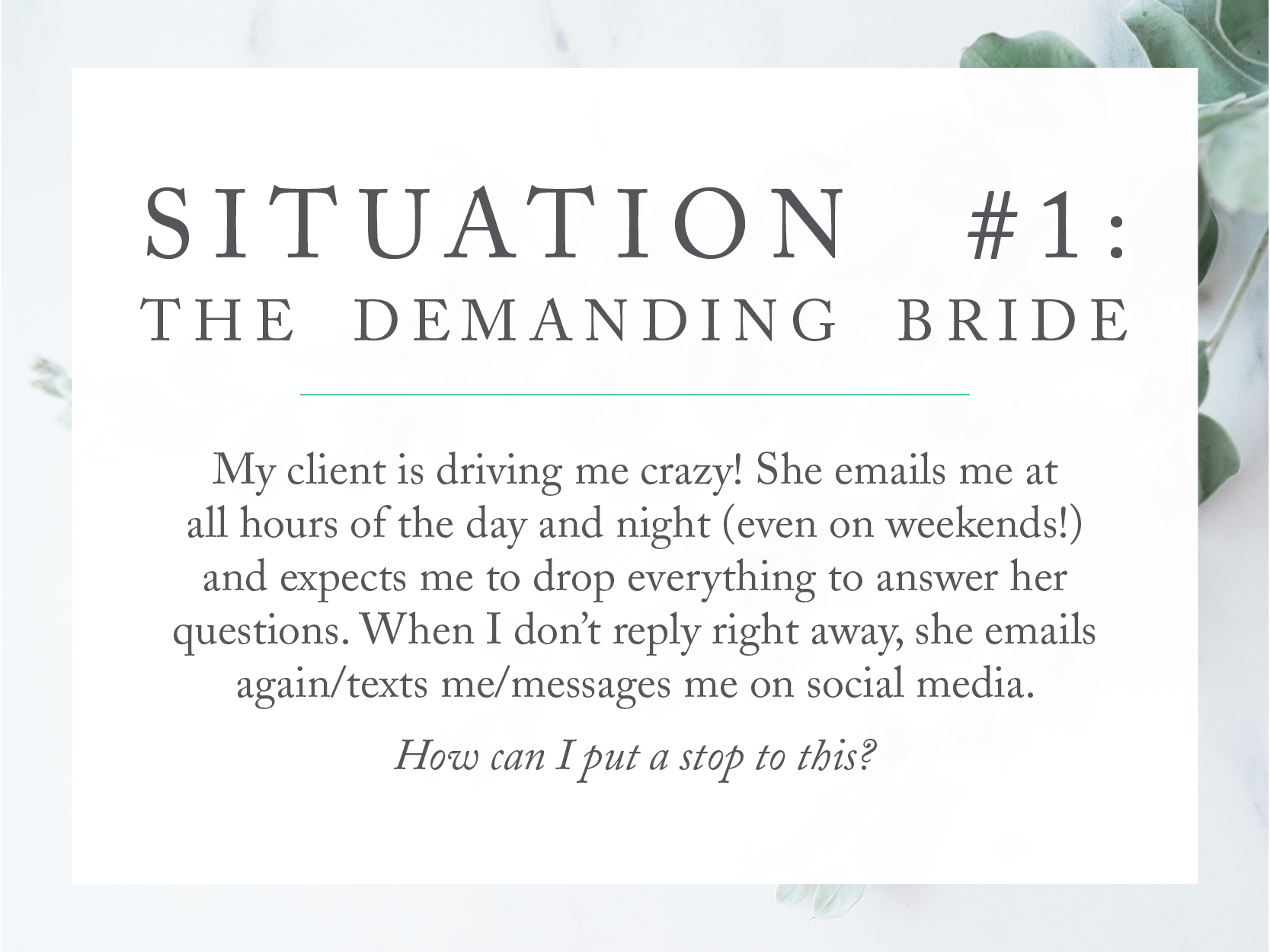
You have the right to set reasonable business hours. If you don’t want to answer client emails on weekends, you don’t have to! It’s so easy to think that with the instant gratification of today’s world that everyone should respond right away, but that’s not a sustainable or reasonable expectation. Here are some options you can experiment with:
- With your next client, make it a point to drop in a short note about your office hours in your first or second email to them. Kindly let them know that while you don’t answer emails on weekends, answering their questions will be your priority when you return to the office Monday morning.
- Don’t fall into the traps your clients set for you. As my colleague Ellen says, there is no such thing as a calligraphy emergency. More on this later.
- While most of the burden is on you, you SHARE responsibility with your client in order to provide your service. She needs to get her information to you in a timely manner, and you need to remind her when she’s not. I’ve never had a client get mad at me for checking in with them every day to see if they have X piece ready yet, and have been thanked for the reminder almost every time.
If you work late but don’t want your clients to know you’re up at 2am working on projects, look into an email scheduling system. There are SO many out there to choose from, just look around!
One thing I’ve learned in my 8 years of being a graphic designer is that clients are very visual. They often don’t know what they really want until they see it, and sometimes they don’t even know then. This isn’t their fault; we have to remind ourselves that we’re creatives, and many people can’t visualize things the same way we can.
The first thing to do when you sense that you’re straying from the style you originally discussed is to get in touch with your client. Try to schedule a phone call or face-to-face meeting so that you can hear and/or see them. That will help both of you communicate, and it’s important to read body language and tone of voice when having these conversations. If you can’t do a phone call or meeting, email will be okay, but you’ll need to be very clear with what your client can expect from here on out.
Once you’ve set your meeting, prepare a list of questions to ask. If she contacted you about creating an invite with brush lettering, but now you’ve moved towards a pointed pen look, find out why. Perhaps she only liked the style of an invitation she saw online, and seeing her name in brush lettering turned her off. Maybe she prefers a different style of brush lettering, or maybe she needs to see a few different variations of her requested copy to find a version she likes.
This is when setting expectations really comes into play. For custom projects, I try to direct my clients towards my website or Instagram page, asking them to send me screenshots of any of my work that they like. For vows or envelope addressing, I send them a photo or a link to my most recent commission so that they get a feel for my most updated style. Also, I’d include something in your contract that says that you only provide X number of revisions per pieces (I recommend 2-3), and anything outside of that will incur an additional fee.
If you’re too deep into these design revisions to implement a contract, gently let the client know that you feel you’ve gone off track. Send her proofs of where you’re at, let her know that you’re happy to make minor changes to the proofs as is, but any additional major design changes (i.e., adding in a paragraph of text, a photo, changing the lettering style, etc.) will incur a design fee of $X per proof/$X per hour.
Remember when I said that there’s no such thing as a calligraphy emergency? This is another one of those cases. Just because your client forgot to include an invitation for Mr. Jackson and his wife doesn’t mean that you should bend over backwards to correct her error. I know that sounds a little harsh, but your time is valuable and important, too! If your client is gracious and willing to pay the fee to rush the envelope addressing and overnight the piece to her, good on her. If she’s not gracious enough, then politely explain to her what exactly goes into that one piece. You can’t just “make it real quick” (as I’m oh, so fond of hearing) and you can’t mail anything to a client for free (because, hey! It costs money to mail packages).
Can you create this extra piece in time to overnight it to the client? If yes, did she give you all the information you need in order to make this happen? Did she pay you for this extra piece and all of the associated costs?
If you can’t physically complete the order and get it to UPS or FedEx in time to be delivered by tomorrow, explain that to the client as simply as you can. Some things are out of your control, and I’m sure she’ll understand that.
And trust me: even though you’re going to want to say that it doesn’t matter whether the invites are mailed out all at once or not, don’t bring it up.
Threats are not okay and your clients should never threaten you. But since I know it happens, let’s talk about what to do in this particular situation.
The first thing you need to ask yourself is this: did you send her a proof before printing? (If you didn’t, you NEED to start doing this. It’s the most common of practices in the design world and it should be second nature to you. I try not to speak in absolutes, but you should NEVER send a piece to print without sending a proof to the client and getting their approval.) Did you state that the client is responsible for proofreading and correcting any errors including spelling, punctuation, grammar, etc., and that they are responsible for reprinting if they approve a piece with an error? Did your client approve said proof? Do you have this approval in writing?
(Disclaimer: I know a lot of designers who are totally okay with verbal approvals to print. I am not, because then it became a game of he said/she said. Everything I do gets put into writing anyway, and anything that is not in writing is, frankly, not official.)
If you sent a proof and the client approved it, there are a few ways you can handle this:
- Depending on the severity of the error, offer a partial refund. This is not my preferred method of resolution, but I know some colleagues who offer this as a resolution.
- If the suite has already been sent out, offer a percentage discount on her day-of pieces to make up for the error. This usually helps diffuse the situation a little bit, but may not fly with some brides. At this point, you should have a pretty good idea of how she’ll react. Be courteous and stand firm, but don’t point fingers. No one wants to hear that they messed up, but there are professional ways to relieve yourself of responsibility. Try something like this: “The proof approved on August 20th gave approval to move the piece to production immediately. I understand that people make mistakes, and would be happy to offer you [refund amount] to alleviate some of the financial burden of reprinting.”
- Offer to reprint the piece for the cost of the printing.
If you did NOT send a proof to the client, or you sent a proof to the client and they gave you a verbal okay, there are a few ways I see a good resolution happening:
- Reprint the piece with the errors. If you’re working with foil or letterpress or another specialty printing type, you may lose some money. Personally, I’d rather have a happy client and be able to sleep well at night than refuse to fix it, so I would reprint.
- Refund for only the pieces with the errors.
- If the suite has already been sent out, offer a percentage discount on her day-of pieces to make up for the error.
I highly encourage you to insert a clause about how important proofing is in your contract (again, if you’re not sending contracts, YOU NEED TO.). Check out The Contract Shop, which offers contracts you can purchase for your creative business. This is not a drill, people. Legitimize yourself!
If your client is still threatening you or being unreasonable (i.e., won’t pay their final bill), it might be time to investigate your options. You can take her to small claims court, hire an attorney, or send her to collections. If you have a contact in place that the client has signed, and proof that she signed off on proofs and approved them to print, it will be much easier to prove that she owes you money legally. Don’t offer any alternative forms of payment or anything other than what your contract specifically states. Oh, and also: I’m not a lawyer and this is not official legal advice.
Take a deep breath and remind yourself that you’re human, and you make mistakes. Got it? Good, now you can move on to the issue at hand. Don’t waste any more time beating yourself up about it, or fuming at the client, or doing anything that doesn’t involve making this situation right – because that’s now your highest priority.
Think about why the client is upset. Did you fail to communicate something to her during the design process, and now she’s upset by the final product? Did you let her email sit in your inbox for a few days because you were swamped with other work? Did you tell her that the price was one number, then send her a final bill for a higher amount?
Remember that you client is likely not part of your industry, so she may not understand some of the industry jargon that you use, which can lead to confusion on both sides. I remember one of my first clients asking for an invitation that was completely hand-lettered, but after further investigation, what she really meant was that she wanted an invitation done completely in modern calligraphy with not computer fonts. To those of us in the industry, hand-lettering and modern calligraphy are not similar to each other in the slightest, but they may be one and the same to a client who has never hired a calligrapher before.
To fix the issue at hand, find your happy place first. If you’re drafting an email response to your client, you’ll be able to control the tone a lot easier. Be sincere, be gracious, and be kind. Don’t go in guns blazing, insisting that you’re right and the client is wrong. Apologize (because in this circumstance, you’re in the wrong – and you’re human so that’s okay, remember?!) and move on to how you’re going to make the situation better. Obviously, each situation would be different, but here’s an example from my graphic design agency days:
Client X: “You left out the part about families being welcome on the flyer. The flyer doesn’t make sense without it!”
Me: “I apologize for my oversight, Client X! I have corrected the mistake and an updated proof is attached for your review. Thank you!”
Here, I’ve corrected the mistake and sent them a new proof in record time. I pushed other client’s work aside to make this change, and apologized for my mistake without sounding like I’m groveling.
Hindsight is 20/20
(a.k.a., one of my mom’s favorite sayings.)
If you’re starting to see a trend with your clients, stop and consider what’s happening. Are there ways you can communicate better? Can you create a pre-made, easy-to-read document that you can send to your brides to set some expectations up front? (Would you like to be able to offer a document like that, but just don’t have the time to create it?)
What are some challenges that you’ve faced as a wedding professional? How did you approach the situation? Tell me in the comments below!

If you have any situations you need help with, drop me a line and I’ll help out as best as I can!
Your question may appear in one of my future “Ask Sablewood” posts!
[contact-form to=”sablewoodpaper@gmail.com” subject=”Ask Sablewood”][contact-field label=”First Name” type=”name” required=”1″][contact-field label=”Email” type=”email” required=”1″][contact-field label=”Ask me a question here:” type=”textarea”][/contact-form]
SaveSave
